
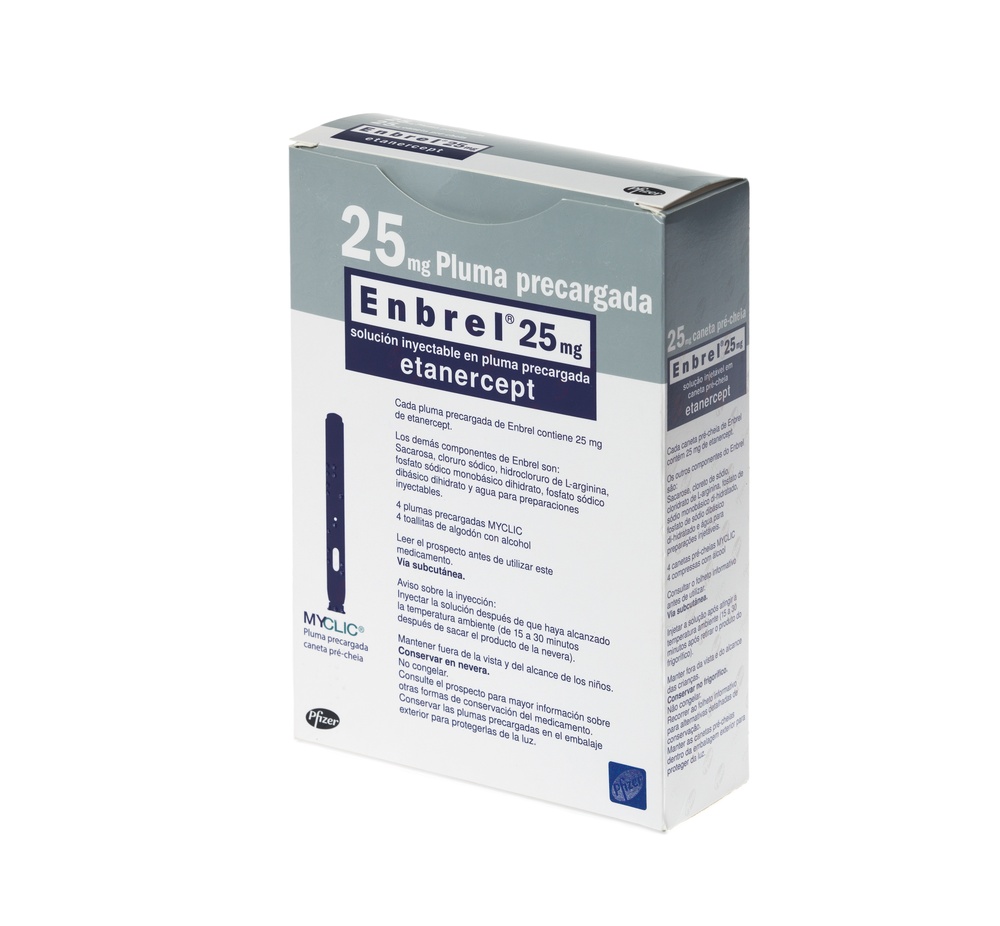
ЕНБРЕЛЬ 25 мг РОЗЧИН ДЛЯ ІН'ЄКЦІЙ У ПЕРЕДНАПОВНЕНІЙ ШПРИЦ-РУЧЦІ


Інструкція із застосування ЕНБРЕЛЬ 25 мг РОЗЧИН ДЛЯ ІН'ЄКЦІЙ У ПЕРЕДНАПОВНЕНІЙ ШПРИЦ-РУЧЦІ
Вступ
Опис: інформація для користувача
Енбрел 25мг розчин для ін'єкційупередовженій стрижні
етанерцепт
Прочитайте уважно весь опис перед тим, як почнете використовувати цей лікарський засіб, оскільки він містить важливу інформацію для вас.
|
Зміст опису
Інформація, яка міститься в цьому описі, організована у наступних 7 розділах:
- Що таке Енбрел і для чого він використовується
- Що потрібно знати до початку використання Енбрелу
- Як використовувати Енбрел
- Можливі побічні ефекти
- Збереження Енбрелу
- Зміст упаковки та додаткова інформація
- Інструкції з використання
1. Що таке Енбрел і для чого він використовується
Енбрел - це лікарський засіб, який виготовляється з двох людських білків. Він блокує дію іншого білка, який знаходиться в організмі, і який викликає запалення. Енбрел діє шляхом зменшення запалення, пов'язаного з певними захворюваннями.
Енбрел можна використовувати у дорослих віком від 18 років для лікування ревматоїдного артриту середньої або тяжкої форми, псоріатичного артриту, аксіальної спондилоартропатії тяжкої форми, включаючи анкілозуючий спондиліт, та псоріазу середньої або тяжкої форми, зазвичай залежно від кожного випадку, коли інші методи лікування не були достатньо ефективними або не підходять для вас.
При лікуванні ревматоїдного артриту Енбрел зазвичай використовується в поєднанні з метотрексатом, хоча його також можна використовувати як єдиний лікарський засіб у разі, якщо лікування метотрексатом не підходить для вас. Енбрел може сповільнити пошкодження, викликані ревматоїдним артритом, у ваших суглобах, та покращити вашу здатність виконувати щоденні дії, як самостійно, так і в поєднанні з метотрексатом.
У разі пацієнтів, які мають псоріатичний артрит з множинним ураженням суглобів, Енбрел може покращити вашу здатність виконувати щоденні дії. У разі пацієнтів, які мають множинні симетричні суглоби, які опухли або болять (наприклад, у руках, зап'ястках та ногах), Енбрел може сповільнити прогресування пошкодження суглобів, викликаного захворюванням.
Енбрел також показаний для лікування дітей та підлітків з наступними захворюваннями:
- Для наступних типів ювенільного ідіопатичного артриту, коли лікування метотрексатом не було достатньо ефективним, або якщо воно не підходить для них:
- Поліартрит (з позитивним або негативним ревматоїдним фактором) та розширений олігоартрит у пацієнтів віком від 2 років.
- Псоріатичний артрит у пацієнтів віком від 12 років.
- Для артриту, пов'язаного з ентезитом, у пацієнтів віком від 12 років, якщо використання інших методів лікування не було достатньо ефективним, або якщо вони не підходять для них.
- Тяжкий псоріаз у пацієнтів віком від 6 років, які мали недостатню реакцію на фототерапію або інші системні методи лікування.
2. Що потрібно знати до початку використання Енбрелу
Не використовуйте Енбрел
- якщо ви або дитина, яка перебуває під вашою опікою, алергічні на етанерцепт або будь-який інший компонент Енбрелу (перелічені в розділі 6). Якщо ви або дитина відчуваєте алергічні реакції, такі як стиснення грудної клітки, задишка, головокружіння або висип, не вводьте Енбрел і негайно проконсультуйтеся з вашим лікарем.
- якщо ви або дитина маєте або ризикуєте розвити тяжку інфекцію крові, яку називають сепсисом. Якщо ви не впевнені, проконсультуйтеся з вашим лікарем.
- якщо ви або дитина маєте будь-яку інфекцію. Якщо ви не впевнені, проконсультуйтеся з вашим лікарем.
Попередження та застереження
Проконсультуйтеся з вашим лікарем до початку використання Енбрелу.
- Алергічні реакції:Якщо ви або дитина відчуваєте алергічні реакції, такі як стиснення грудної клітки, задишка, головокружіння або висип, не вводьте Енбрел і негайно проконсультуйтеся з вашим лікарем.
- Інфекції/хірургія:Якщо ви або дитина розвиваєте нову інфекцію або готуєтеся до великої хірургічної операції, ваш лікар може бути зацікавлений у контролі лікування Енбрелом.
- Інфекції/цукровий діабет:Повідомте вашому лікареві, якщо ви або дитина маєте історію повторюваних інфекцій або якщо ви маєте цукровий діабет чи інші розлади, які збільшують ризик інфекції.
- Інфекції/мониторинг:Повідомте вашому лікареві про будь-які недавні поїздки за межі Європи. Якщо ви або дитина розвиваєте симптоми інфекції, такі як гарячка, озноб або кашель, негайно повідомте вашому лікареві. Ваш лікар повинен вирішити, чи продовжувати моніторинг вас або дитини на наявність інфекцій після закінчення лікування Енбрелом.
- Туберкульоз:Оскільки були повідомлення про випадки туберкульозу у пацієнтів, які приймали Енбрел, ваш лікар огляне ознаки та симптоми туберкульозу до початку лікування Енбрелом. Це може включати детальний огляд вашої медичної історії, рентгенографію грудної клітки та тест на туберкульоз. Виконання цих тестів повинно бути зареєстровано в Карточці інформації пацієнта. Дуже важливо повідомити вашому лікареві, якщо ви або дитина мали туберкульоз або були в безпосередньому контакті з людиною, яка мала туберкульоз. Якщо симптоми туберкульозу (такі як тривала кашель, вагова недостатність, апатія, помірна гарячка) або будь-яка інша інфекція з'являються під час або після лікування, негайно повідомте вашому лікареві.
- Гепатит Б:Повідомте вашому лікареві, якщо ви або дитина мали гепатит Б будь-коли. Ваш лікар повинен провести тест на гепатит Б до початку лікування Енбрелом. Лікування Енбрелом може реактивувати гепатит Б у пацієнтів, які раніше були інфіковані вірусом гепатиту Б. Якщо це відбувається, вам потрібно припинити використання Енбрелу.
- Гепатит С:Повідомте вашому лікареві, якщо ви або дитина маєте гепатит С. Ваш лікар може бажати моніторити лікування Енбрелом у разі погіршення інфекції.
- Розлади крові:Негайно повідомте вашому лікареві, якщо ви або дитина маєте ознаки чи симптоми, такі як тривала гарячка, біль у горлі, синяки, кровотеча або блідість. Такі симптоми можуть вказувати на серйозну проблему з кров'ю, яка потребує переривання лікування Енбрелом.
- Розлади нервової системи та зору:Повідомте вашому лікареві, якщо ви або дитина маєте розсіяний склероз, неврит оптичного нерва (запалення зорового нерва) або транзиторний мієліт (запалення спинного мозку). Ваш лікар вирішить, чи підходить Енбрел для лікування.
- Серцева недостатність:Повідомте вашому лікареві, якщо ви або дитина маєте історію серцової недостатності, оскільки Енбрел потрібно використовувати з обережністю в таких випадках.
- Рак:Повідомте вашому лікареві, якщо ви мали лімфому (тип кров'яного раку) або будь-який інший рак до початку лікування Енбрелом.
Пацієнти з ревматоїдним артритом тяжкої форми, які мали захворювання протягом тривалого часу, можуть мати підвищений ризик розвитку лімфоми.
Діти та дорослі, які приймають Енбрел, можуть мати підвищений ризик розвитку лімфоми або іншого раку.
Деякі підлітки та діти, які приймали Енбрел або інші лікарські засоби, які діють аналогічно Енбрелу, розвивали рак, включаючи рідкісні типи, які іноді призводили до смерті.
Деякі пацієнти, які приймали Енбрел, розвивали рак шкіри. Повідомте вашому лікареві, якщо ви або дитина маєте будь-які зміни на шкірі або пухлини на шкірі.
- Вітрянка:Повідомте вашому лікареві, якщо ви або дитина були інфіковані вітрянкою під час використання Енбрелу. Ваш лікар вирішить, чи потрібно профілактичне лікування вітрянки.
- Латекс:Капсула голки у стрижні MYCLIC виготовлена з латексу (сухої натуральної гуми). Проконсультуйтеся з вашим лікарем до використання Енбрелу, якщо капсула голки буде оброблятися або якщо Енбрел буде вводитися особою з відомою алергією на латекс.
- Алкоголізм:Енбрел не повинен використовуватися для лікування гепатиту, пов'язаного з алкоголізмом. Будь ласка, повідомте вашому лікареві, якщо ви або дитина, яка перебуває під вашою опікою, маєте історію алкоголізму.
- Гранулематоз Вегенера:Енбрел не рекомендується для лікування гранулематозу Вегенера, рідкісного запального захворювання. Якщо ви або дитина, яка перебуває під вашою опікою, маєте гранулематоз Вегенера, обговоріть це з вашим лікарем.
- Протидіабетичні лікарські засоби: Повідомте вашому лікареві, якщо ви або дитина маєте цукровий діабет або приймаєте лікарські засоби для лікування цукрового діабету. Ваш лікар може вирішити, чи потрібно зменшити дозу протидіабетичного лікарського засобу під час лікування Енбрелом.
Діти та підлітки
Вакцинація:Якщо це можливо, діти повинні мати всі вакцини до початку використання Енбрелу. Деякі вакцини, такі як оральна вакцина проти поліомієліту, не повинні вводитися під час використання Енбрелу. Проконсультуйтеся з вашим лікарем до використання будь-якої вакцини.
Зазвичай Енбрел не повинен використовуватися у дітей молодших 2 років з поліартритом або розширеним олігоартритом, у дітей молодших 12 років з артритом, пов'язаним з ентезитом, або псоріатичним артритом, чи у дітей молодших 6 років з псоріазом.
Інші лікарські засоби та Енбрел
Повідомте вашому лікареві або фармацевту, якщо ви або дитина приймаєте, нещодавно приймали або можете приймати будь-який інший лікарський засіб (включаючи анакінру, абатацепт або сульфасалазин), навіть якщо вони не призначені вашим лікарем. Ви або дитина не повинні приймати Енбрел разом з лікарськими засобами, які містять активні речовини анакінру або абатацепту.
Вагітність та лактація
Енбрел повинен використовуватися під час вагітності тільки у разі явної необхідності. Проконсультуйтеся з вашим лікарем, якщо ви вагітні, думаєте, що можете бути вагітні, або плануєте вагітність.
Якщо ви приймали Енбрел під час вагітності, ваша дитина може мати підвищений ризик інфекції. Крім того, у одному дослідженні було виявлено більше вад розвитку при прийомі Енбрелу під час вагітності порівняно з матерями, які не приймали Енбрел чи інші подібні лікарські засоби (антагоністи фактору некрозу), але не було жодного шаблону у типах вад розвитку, які були повідомлені. Інше дослідження не виявило підвищеного ризику вад розвитку при прийомі Енбрелу під час вагітності. Ваш лікар допоможе вам вирішити, чи переважують користі лікування потенційний ризик для вашої дитини.
Проконсультуйтеся з вашим лікарем, якщо ви хочете годувати грудьми під час лікування Енбрелом. Важливо повідомити вашому педіатру та іншим медичним працівникам про використання Енбрелу під час вагітності та лактації до того, як ваша дитина отримає будь-яку вакцину.
Водіння транспортних засобів та використання машин
Не очікується, що використання Енбрелу вплине на вашу здатність водити транспортні засоби та використовувати машини.
Енбрел містить натрій
Цей лікарський засіб містить менше 1 ммоль натрію (23 мг) на одну дозу; тобто, він практично не містить натрію.
3. Як використовувати Енбрел
Слідуйте точно інструкціям з введення цього лікарського засобу, які вказані вашим лікарем. У разі сумнівів проконсультуйтеся з вашим лікарем або фармацевтом.
Якщо ви вважаєте, що дія Енбрелу є надто сильною або слабкою, повідомте вашому лікареві або фармацевту.
Ваш лікар призначив вам дозу Енбрелу 25 мг. Крім того, доступна є доза Енбрелу 50 мг для введення дози 50 мг.
Доза для дорослих пацієнтів (віком 18 років та старше)
Ревматоїдний артрит, псоріатичний артрит та аксіальна спондилоартропатія, включаючи анкілозуючий спондиліт
Звичайна доза становить 25 мг, введених двічі на тиждень або 50 мг, введених один раз на тиждень, у вигляді ін'єкції під шкіру. Однак ваш лікар може вирішити іншу частоту введення Енбрелу.
Псоріаз у плаках
Звичайна доза становить 25 мг двічі на тиждень або 50 мг один раз на тиждень.
Альтернативно, можуть вводитися 50 мг двічі на тиждень протягом максимально 12 тижнів, після чого вводяться 25 мг двічі на тиждень або 50 мг один раз на тиждень.
Ваш лікар вирішить, як довго вам потрібно приймати Енбрел, та чи потрібно повторення лікування залежно від вашої реакції. Якщо Енбрел не має ефекту на ваше захворювання після 12 тижнів, ваш лікар може порадити вам припинити використання цього лікарського засобу.
Використання у дітей та підлітків
Адекватна доза та частота введення залежать від ваги дитини та захворювання. Ваш лікар визначить адекватну дозу для дитини та призначить найбільш підходящу форму Енбрелу (10 мг, 25 мг або 50 мг).
Для поліартриту або розширеного олігоартриту у пацієнтів віком від 2 років, або артриту, пов'язаного з ентезитом, або псоріатичного артриту у пацієнтів віком від 12 років, звичайна доза становить 0,4 мг Енбрелу на кілограм ваги (до максимально 25 мг) двічі на тиждень або 0,8 мг Енбрелу на кілограм ваги (до максимально 50 мг) один раз на тиждень.
Для псоріазу у пацієнтів віком від 6 років звичайна доза становить 0,8 мг Енбрелу на кілограм ваги (до максимально 50 мг) один раз на тиждень. Якщо Енбрел не має ефекту на захворювання дитини після 12 тижнів, ваш лікар може порадити вам припинити використання цього лікарського засобу.
Ваш лікар дасть вам точні інструкції щодо підготовки та розрахунку правильної дози.
Форма та спосіб введення
Енбрел вводиться шляхом ін'єкції під шкіру (підшкірної ін'єкції).
Енбрел можна вводити з або без їжі чи напоїв.
Урозділі 7, "Інструкції з використання", містяться детальні інструкції щодо введення Енбрелу.Розчин Енбрелу не повинен змішуватися з будь-яким іншим лікарським засобом.
Щоб вам допомогти запам'ятати, можна буде записати в щоденник, який день(і) тижня вам потрібно використовувати Енбрел.
Якщо ви використали більше Енбрелу, ніж потрібно
Якщо ви використали більше Енбрелу, ніж потрібно (або ввели велику кількість за один раз, або використали його занадто часто), вам потрібно негайно проконсультуватися з лікарем або фармацевтом. Завжди носіть з собою упаковку лікарського засобу, навіть якщо вона пуста.
Якщо ви забули ввести Енбрел
Якщо ви забули ввести дозу, вам потрібно ввести її якнайшвидше, коли ви це пам'ятаєте, якщо тільки наступна доза не призначена на наступний день, у цьому випадку вам потрібно пропустити забуту дозу. Потім продовжуйте вводити лікарський засіб у звичайний день(і). Якщо ви не пам'ятаєте до наступного дня, коли вам потрібно ввести наступну дозу, не вводьте подвійну дозу (дві дози в один день) для компенсації забутої дози.
Якщо ви припинили лікування Енбрелом
Ваши симптоми можуть повернутися після припинення лікування.
Якщо в вас є будь-які інші питання щодо використання цього лікарського засобу, проконсультуйтеся з вашим лікарем або фармацевтом.
4. Можливі побічні ефекти
Як і всі лікарські засоби, цей лікарський засіб може викликати побічні ефекти, хоча не всі люди їх відчувають.
Алергічні реакції
Якщо ви спостерігали одну з наступних реакцій, не вводьте більше Енбрел. Повідомте своєму лікарю негайно або зверніться до відділення невідкладної допомоги найближчої лікарні.
- Труднощі з ковтанням або диханням.
- Набухання обличчя, горла, рук і ніг.
- Чувство нервозності або тривоги, серцебиття, раптове почервоніння шкіри і/або відчуття жару.
- Серйозна висипка, свербіж або кропив'янка (видатні червоні або бліді висипки на шкірі, часто супроводжувані свербінням).
Серйозні алергічні реакції рідкісні. Однак будь-який з вище згаданих симптомів може бути ознакою алергічної реакції на Енбрел, тому ви повинні негайно звернутися за медичною допомогою.
Серйозні побічні ефекти
Якщо ви помітили будь-який з наступних ефектів, ви або дитина можуть потребувати невідкладної медичної допомоги.
- Ознаки серйозних інфекцій, таких як висока температура, що супроводжується кашлем, задиханням, ознобом, слабістю або болючою, чутливою ділянкою шкіри або суглобів.
- Ознаки забурень крові, таких як кровотеча, синяки або блідість.
- Ознаки забурень нервової системи, таких як оніміння або поколювання, порушення зору, біль в очах або появлення слабкості в руці або нозі.
- Ознаки недостатності серця або погіршення недостатності серця, таких як втома або задихання під час діяльності, набухання щиколоток, відчуття повноти в шиї або в животі, задихання вночі або кашель, синій колір нігтів або навколо губ.
- Ознаки раку: рак може впливати на будь-яку частину тіла, включаючи шкіру та кров, і можливі ознаки залежать від типу та місця розташування раку. Ці ознаки можуть бути, серед іншого, втратою ваги, лихоманкою, набуханням (з болем або без), тривалим кашлем, наявністю шишок або загустень на шкірі.
- Ознаки автоімунних реакцій(при яких розвиваються антитіла, які можуть пошкоджувати нормальні тканини тіла) таких як біль, свербіж, слабість і дихання, мислення, відчуття або зір анормального.
- Ознаки системного червоного вовчакатаких як зміни ваги, тривала висипка, лихоманка, біль у м'язах або суглобах або втома.
- Ознаки васкулітівтаких як біль, лихоманка, червоність або жар шкіри, або свербіж.
Ці побічні ефекти рідкісні або мало поширені, але вони є серйозними станами (дехто з них у рідких випадках може бути смертельним). Якщо ці ознаки трапляються, повідомте своєму лікарю негайно або зверніться до відділення невідкладної допомоги найближчої лікарні.
Наступні побічні ефекти Енбрелу відомі, згруповані за зменшенням частоти:
- Дуже поширені(можуть впливати на більше 1 з 10 осіб):
Інфекції (включно з застудою, синуситом, бронхітом, інфекціями сечовивідних шляхів та інфекціями шкіри); реакції на місці ін'єкції (включно з кровотечею, синяком, червоністю, свербінням, болем та набуханням) (не відбувається так часто після першого місяця лікування; деякі пацієнти розвинули реакцію на місці ін'єкції, яку вони використовували нещодавно); та головний біль.
- Поширені(можуть впливати до 1 з 10 осіб):
Алергічні реакції; лихоманка; висипка; свербіж; антитіла, спрямовані проти нормальних тканин (утворення автоантитіл).
- Мало поширені(можуть впливати до 1 з 100 осіб):
Серйозні інфекції (включно з пневмонією, інфекціями не поверхневої шкіри, інфекціями суглобів, інфекцією крові та загальними інфекціями); погіршення недостатності серця; низький рівень червоних кров'яних тіл, низький рівень білих кров'яних тіл, низький рівень нейтрофілів (тип білих кров'яних тіл); низький рівень тромбоцитів; рак шкіри (крім меланоми); локалізоване набухання шкіри (ангіоневротичний набухання); кропив'янка (видатні червоні або бліді висипки на шкірі, часто супроводжувані свербінням); запалення очей, псоріаз (новий або погіршення); запалення кров'яних судин, що впливає на кілька органів; підвищення рівня печінкових ферментів у аналізах крові (у пацієнтів, які також приймають лікування метотрексатом, підвищення рівня печінкових ферментів є поширеним); судоми в животі та біль, діарея, втрата ваги або кров у калових масах (ознаки проблем з кишечником).
- Рідкісні(можуть впливати до 1 з 1000 осіб):
Серйозні алергічні реакції (включно з локалізованим серйозним набуханням шкіри та задиханням); лімфома (тип кров'яного раку); лейкоз (рак, який впливає на кров та кістковий мозок); меланома (тип раку шкіри); поєднання низького рівня червоних кров'яних тіл, білих кров'яних тіл та тромбоцитів; порушення нервової системи (з серйозною м'язевою слабістю та ознаками, подібними до множинного склерозу або запалення очних нервів чи спинного мозку); туберкульоз; недостатність серця; судоми; системний червоний вовчак або синдром, подібний до системного червоного вовчака (симптоми можуть включати тривалу висипку, лихоманку, біль у суглобах та втому); висипка на шкірі, яка може призвести до серйозного утворення пухирів та лущення шкіри; лікеноподібні реакції (свербіжна червона-пурпурна висипка на шкірі та/або товсті біло-сірі лінії на слизових оболонках); запалення печінки, викликані імунною системою (автоімунний гепатит; у пацієнтів, які також приймають лікування метотрексатом, частота є мало поширеною); імунологічний розлад, який може вплинути на легені, шкіру та лімфатичні вузли (саркоїдоз); запалення чи рубцювання легень (у пацієнтів, які також приймають лікування метотрексатом, частота запалення чи рубцювання легень є мало поширеною); пошкодження малих фільтрів всередині нирок, що призводить до порушень ниркової функції (гломерулонефрит).
- Дуже рідкісні(можуть впливати до 1 з 10 000 осіб):
Недостатність кісткового мозку для виробництва критичних клітин крові.
- Частота невідома(не може бути оцінена на основі доступних даних):
Карцинома Меркеля (тип раку шкіри); саркома Капоші, рідкісний рак, пов'язаний з інфекцією вірусом людського герпесу 8. Саркома Капоші зазвичай проявляється частіше як пурпурні висипки на шкірі; надмірна активація білих кров'яних тіл, пов'язана з запаленням (синдром активації макрофагів); реактивація гепатиту Б (інфекція печінки); погіршення захворювання, відомого як дерматоміозит (запалення та слабкість м'язів, супроводжувані висипкою на шкірі).
Інші побічні ефекти у дітей та підлітків
Побічні ефекти, спостережені у дітей та підлітків, а також їх частота, подібні до тих, що описані вище.
Звіт про побічні ефекти
Якщо ви відчуваєте будь-який побічний ефект, проконсультуйтеся з лікарем або фармацевтом, навіть якщо це можливі побічні ефекти, які не вказані в цьому описі. Ви також можете повідомити про них безпосередньо через систему фармакологічного нагляду за лікарськими засобами для людини: www.notificaRAM.es. Надсилаючи повідомлення про побічні ефекти, ви можете допомогти забезпечити більше інформації про безпеку цього лікарського засобу.
5. Зберігання Енбрелу
Тримайте цей лікарський засіб поза зоною видимості та досягнення дітей.
Не використовуйте цей лікарський засіб після закінчення терміну придатності, вказаного на упаковці та на попередньо заповненій стрижні MYCLIC після "EXP". Термін придатності - останній день місяця, який вказано.
Зберігайте у холодильнику (2 °C - 8 °C). Не заморожуйте.
Тримайте попередньо заповнені стрижні в зовнішній упаковці, щоб захистити їх від світла.
Після видалення попередньо заповненої стрижні з холодильника чекайте приблизно від15 до30 хвилин, щоб дозволити розчиненню Енбрелуустрижні досягти кімнатної температури.Не нагрівайте його жодним іншим способом. Потім рекомендується негайне використання.
Енбрел можна зберігати поза холодильником при максимальній температурі 25 °C протягом одного періоду до 4 тижнів; після чого лікарський засіб не можна знову охолодити. Енбрел слід викидати, якщо він не був використаний протягом 4 тижнів після видалення з холодильника. Рекомендується, щоб ви зробили запис про дату, коли Енбрел був видалений з холодильника, та дату, з якої Енбрел слід викидати (не пізніше 4 тижнів після видалення з холодильника).
Перегляньте розчин у стрижні, подивившись крізь прозору вікно інспекції. Розчин повинен бути прозорим або легенько опалесцентним, безколірним до світло-жовтого або блідо-коричневого кольору, і може містити дрібні білкові частинки або майже прозорі. Це є нормальним виглядом Енбрелу. Не використовуйте розчин, якщо він забарвлений або мутний, або якщо він містить частинки, інші ніж ті, що описані вище. Якщо вас турбує вигляд розчину, зверніться до фармацевта за допомогою.
Лікарські засоби не слід викидати у каналізацію чи сміття. Спитайте у фармацевта, як позбутися упаковок та лікарських засобів, які вам більше не потрібні. Таким чином, ви допоможете захистити навколишнє середовище.
6. Зміст упаковки та додаткова інформація
Склад Енбрел
Активний інгредієнт Енбрел - етанерцепт. Кожна попередньо наповнена п'єса MYCLIC Енбрел містить 25 мг етанерцепту.
Інші компоненти - сахароза, хлорид натрію, гідрохлорид L-аргініну, монобазичний дигідрат фосфату натрію, дібазичний дигідрат фосфату натрію та вода для ін'єкційних препаратів.
Вигляд продукту та вміст упаковки
Енбрел представлений у вигляді ін'єкційної розв'язки в попередньо наповненій п'єсі (MYCLIC) (ін'єкційна розв'язка). П'єса MYCLIC містить прозору ін'єкційну розв'язку, безбарвну чи злегка опалесцентну, від безбарвної до світло-жовтого чи світло-коричневого кольору. Кожна упаковка містить 4, 8 або 24 п'єси та 4, 8 або 24 ватні підкладки з алкоголем.Можливо, що тільки деякі розміри упаковок будуть продаватися.
Власник дозволу на продаж:Pfizer Europe MA EEIG Boulevard de la Plaine 17 1050 Брюссель Бельгія | |
Виробник: Pfizer Manufacturing Belgium NV Rijksweg 12, 2870 Пурс-Сінт-Амандс Бельгія |
Для отримання додаткової інформації щодо цього лікарського засобу зверніться до місцевого представника власника дозволу на продаж:
Іспанія
Pfizer, S.L.
Телефон: +34 91 490 99 00
Дата останнього перегляду цієї інструкції:
Детальна інформація про цей лікарський засіб доступна на сайті Європейського агентства з лікарських засобів: http://www.ema.europa.eu.
- Інструкції з використання
Енбрел 25мг ін'єкційна розв'язка в попередньо наповненій п'єсі
(етанерцепт)
Тільки для підшкірних ін'єкцій
Введення
- Наступні інструкції пояснюють, як використовувати п'єсу MYCLIC для ін'єкції Енбрел.
- Вважно прочитайте інструкції та дотримуйтесь їх крок за кроком.
- Ваш лікар скаже вам, як ін'єкціювати Енбрел. Не намагайтесь зробити ін'єкцію, поки не будете впевнені, що розумієте, як правильно використовувати п'єсу MYCLIC.
- Якщо у вас виникли питання щодо ін'єкції, зверніться до вашого лікаря за допомогою.
Попередньо наповнена п'єса MYCLIC
Перед ін'єкцією
| |||
Біла кришка голки | |||
Сіра кнопка активації | Термін придатності | Прозора вікна інспекції |
Після ін'єкції
| ||
Вікно інспекції заповнене | Відкритий кінець - захисний пристрій |
Крок 1 Підготуйтеся до ін'єкції Енбрел
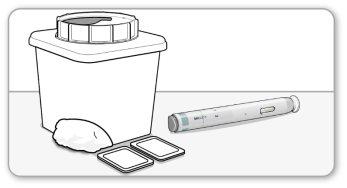
- Зіберітьнаступні матеріали для кожної ін'єкції на рівній, чистій та добре освітленій поверхні:
о попередньо наповнена п'єса MYCLIC.
о ватна підкладка, змочена алкоголем.
о відповідний контейнер для гострих предметів (не входить до складу).
о чисті ватні підкладки або марлі (не входить до складу).
- Непотрясайте п'єсу.
- Незніміть білу кришку, поки вам не буде сказано.
- Для більш комфортної ін'єкції залиште п'єсу при кімнатній температурі (між 15 та 30 хвилинами) з білою кришкою.
- Ненагрівайте п'єсу жодним іншим способом.
Крок 2 Перевірте термін придатності та дозу на етикетці
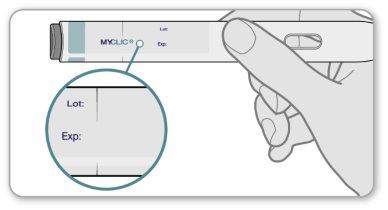
- Перевіртетермін придатності (місяць/рік) на етикетці п'єси.
- Переконайтесьу тому, що на етикетці п'єси вказана правильна доза.
- Якщо термін придатності закінчився або це не призначена доза, невикористовуйте п'єсу та зверніться до вашого лікаря за допомогою.
Крок 3 Інспектуйте лікарський засіб
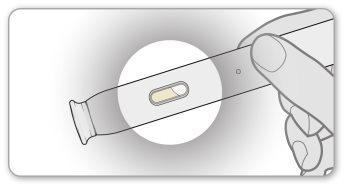
- Інспектуйтелікарський засіб у п'єсі, дивлячись через прозору вікну інспекції. Розв'язка повинна бути прозорою або злегка опалесцентною, від безбарвної до світло-жовтого чи світло-коричневого кольору, і може містити дрібні білові частинки або майже прозорі. Це є нормальним виглядом Енбрел.
- Невикористовуйте лікарський засіб, якщо він має зміни кольору, є мутним або містить частинки, відмінні від тих, що описані вище. Якщо вас турбує вигляд лікарського засобу, зверніться до вашого лікаря за допомогою.
- Примітка:можливо, ви побачите повітряну бульку у вікні інспекції. Це є нормально.
Крок 4 Виберіть та очистіть місце ін'єкції
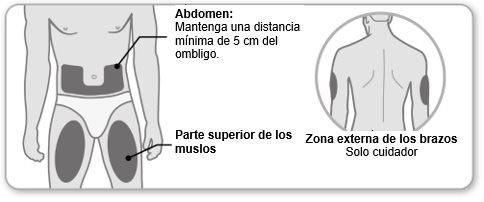
- Виберітьмісце ін'єкції у центрі верхньої частини стегон або у зоні живота, на відстані 5 см від пупка. Зовнішня частина верхньої частини рук також може бути використана опікуном.
- Кожнаін'єкція повинна бути зроблена на відстані не менше 3 см від місця попередньої ін'єкції. Неробіть ін'єкцію в чутливі, потріскані або загрубілі ділянки шкіри. Уникайте ділянок з рубцями або стріями. Якщо у вас є псоріаз, неробіть ін'єкцію безпосередньо в будь-які висячі, товсті, червоні чи лущені ділянки шкіри.
- Очистітьмісце ін'єкції водою та мильним розчином або, якщо ви бажаєте, ватною підкладкою, змоченою алкоголем.
- Дайтейому висохнути. Неторкайтеся, не шанобливо чи не дмухайте на місце ін'єкції.
Крок 5 Зніміть кришку голки
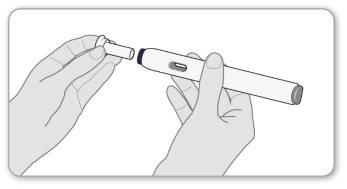
- Знімітьбілу кришку голки, потягнувши її прямо. Незгинайте кришку при зніманні.
- Неповертайте кришку після зняття.
- Після зняття кришки ви побачите фіолетовий захисний пристрій, який трохи виступає з кінця п'єси. Нештовхайте захисний пристрій кінця пальцями чи великим пальцем.
- Невикористовуйте п'єсу, якщо вона впала з голкою, відкритою.
Примітка:можливо, ви помітите краплю рідини на кінчику голки. Це є нормально.
Крок 6 Натисніть п'єсу твердо проти шкіри
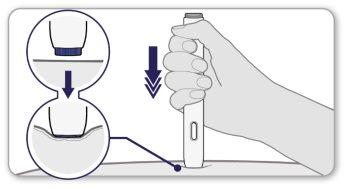
- Натиснітьвідкритий кінець п'єси твердо проти шкіри під кутом 90 градусів, так щоб фіолетовий захисний пристрій голки був повністю всередині п'єси.
Примітка:ви зможете натиснути сіру кнопку тільки тоді, коли захисний пристрій голки буде повністю введений у п'єсу.
Потрібно помітити шкіру перед ін'єкцією, щоб зробити місце ін'єкції твердішим, що полегшить натискання кнопки ін'єкції.
Крок 7 Почніть ін'єкцію
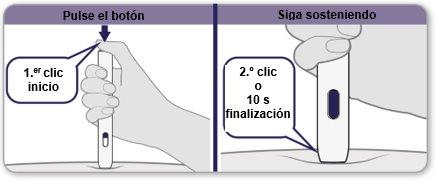
- Натиснітьсіру кнопку до кінця та почуєте «клік». Клік означає початок ін'єкції.
- Тримайтеп'єсу твердо проти шкіри, поки не почуєте другий «клік», або поки не мине 10 секунд після першого кліку (що відбувається раніше).
Примітка:якщо ви не можете почати ін'єкцію, як описано, натисніть п'єсу твердо проти шкіри та знову натисніть сіру кнопку.
Крок 8 Відокреміть п'єсу від шкіри
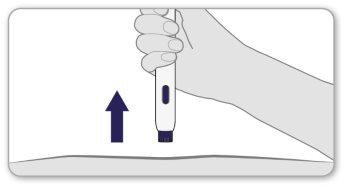
- Відокремітьп'єсу від шкіри, піднімаючи її прямо з місця ін'єкції.
- Фіолетовий захисний пристрій голки автоматично витягнеться, щоб закрити голку.
Крок 9 Перевірте вікно інспекції
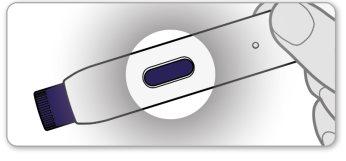
- Перевіртевікно інспекції п'єси. Воно повинно бути повністю фіолетовим.
- Якщо вікно не фіолетове, можливо, ви не отримали повну дозу. Зверніться до вашого лікаря за допомогою. Ненамагайтесь використовувати п'єсу знову. Ненамагайтесь використовувати іншу п'єсу.
- Якщо ви побачите пляму крові на місці ін'єкції, натисніть ватну підкладку або марлю на місце ін'єкції протягом 10 секунд. Нетертіть місце ін'єкції.
Примітка:кнопка ін'єкції може залишатися натисненою. Це є нормально.
Крок 10 Виведення
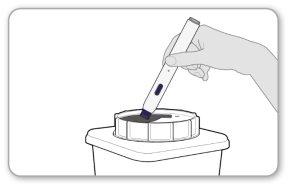
- Виведітьвикористану п'єсу, слідуючи інструкціям вашого лікаря. Ненамагайтесь знову закрити п'єсу.
- Ненатискуйте на кінець захисного пристрою голки. Якщо у вас є питання, зверніться до вашого лікаря.
—Кінець інструкцій з використання—
- Країна реєстрації
- Діючі речовини
- Потрібен рецептТак
- Виробник
- Інформація є довідковою і не є медичною порадою. Перед прийомом будь-яких препаратів обов'язково проконсультуйтеся з лікарем. Oladoctor не несе відповідальності за медичні рішення, прийняті на основі цього контенту.
- Альтернативи до ЕНБРЕЛЬ 25 мг РОЗЧИН ДЛЯ ІН'ЄКЦІЙ У ПЕРЕДНАПОВНЕНІЙ ШПРИЦ-РУЧЦІФорма випуску: РОЗЧИН ДЛЯ ІН'ЄКЦІЙ, 25 мгДіючі речовини: etanerceptВиробник: Samsung Bioepis Nl B.V.Потрібен рецептФорма випуску: ІН'ЄКЦІЙНИЙ, 50 мгДіючі речовини: etanerceptВиробник: Samsung Bioepis Nl B.V.Потрібен рецептФорма випуску: РОЗЧИН ДЛЯ ІН'ЄКЦІЙ, 50 мгДіючі речовини: etanerceptВиробник: Samsung Bioepis Nl B.V.Потрібен рецепт
Аналоги ЕНБРЕЛЬ 25 мг РОЗЧИН ДЛЯ ІН'ЄКЦІЙ У ПЕРЕДНАПОВНЕНІЙ ШПРИЦ-РУЧЦІ в інших країнах
Найкращі аналоги з тією самою діючою речовиною та терапевтичним ефектом.
Аналог ЕНБРЕЛЬ 25 мг РОЗЧИН ДЛЯ ІН'ЄКЦІЙ У ПЕРЕДНАПОВНЕНІЙ ШПРИЦ-РУЧЦІ у Ukraina
Лікарі онлайн щодо ЕНБРЕЛЬ 25 мг РОЗЧИН ДЛЯ ІН'ЄКЦІЙ У ПЕРЕДНАПОВНЕНІЙ ШПРИЦ-РУЧЦІ
Консультація щодо дозування, побічних ефектів, взаємодій, протипоказань та поновлення рецепта на ЕНБРЕЛЬ 25 мг РОЗЧИН ДЛЯ ІН'ЄКЦІЙ У ПЕРЕДНАПОВНЕНІЙ ШПРИЦ-РУЧЦІ – за рішенням лікаря та згідно з місцевими правилами.







